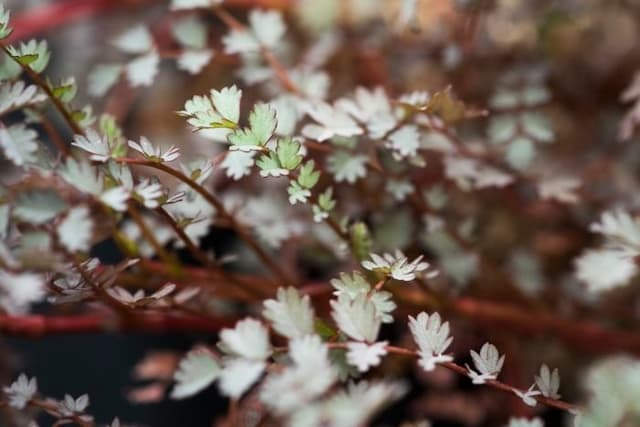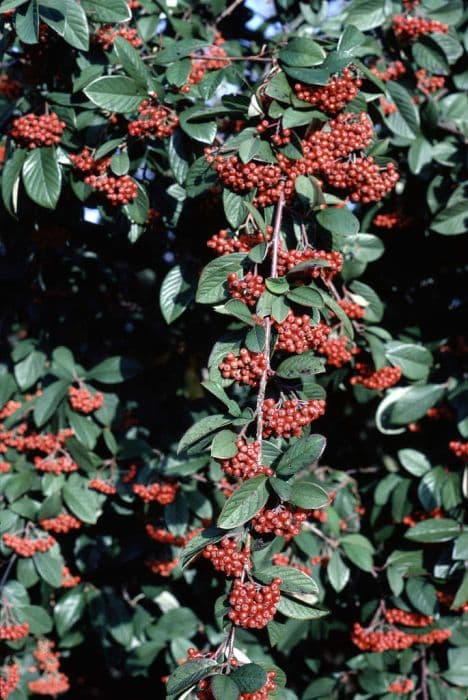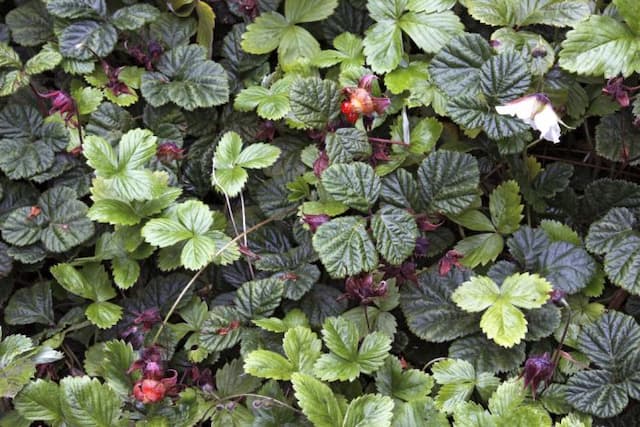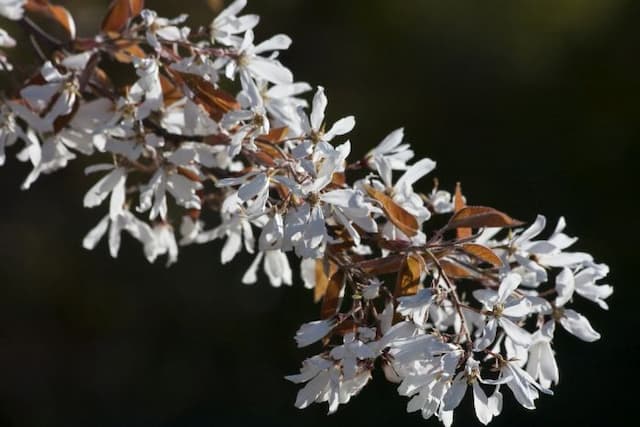Purple-leaf Blackthorn Prunus spinosa 'Purpurea'

ABOUT
Prunus spinosa 'Purpurea', commonly known as purple-leaf blackthorn, is a deciduous shrub known for its distinctive foliage and blossom. In spring, purple-leaf blackthorn is adorned with small, delicate white flowers that emerge before the leaves, offering a stark and beautiful contrast against the dark twigs. As the season progresses, the leaves unfurl, showcasing a dramatic purple coloration that can range from a rich burgundy to a deep plum shade, depending on the light and environment. The leaves are oval-shaped, with a finely serrated edge, and can create a dense canopy that provides a lush appearance throughout the growing season. As summer transitions to autumn, the shrub produces small, round fruits known as sloes. These are initially green, turning to a dark, bluish-black as they ripen. The sloes are favored for making traditional sloe gin and have a tart taste. The bark of the purple-leaf blackthorn is dark and rough, adding textural interest to the garden throughout the year.
About this plant
 Names
NamesFamily
Rosaceae
Synonyms
Purple-leaf Blackthorn, Purple-leaf Sloe, Purpurea Blackthorn
Common names
Prunus spinosa 'Purpurea'.
 Toxicity
ToxicityTo humans
The common name of Prunus spinosa 'Purpurea' is purple-leafed blackthorn. Typically, the fruit of the blackthorn bush is not toxic to humans and is often used in making sloe gin and jellies. However, the seeds, like those of many other Prunus species, contain amygdalin, which can release cyanide when chewed or digested. Ingestion of large quantities of seeds can lead to cyanide poisoning. Symptoms of this type of poisoning may include headache, dizziness, confusion, anxiety, shortness of breath, and potentially seizures, coma, and death if not treated promptly.
To pets
The common name of Prunus spinosa 'Purpurea' is purple-leafed blackthorn. Blackthorn, similar to its effects on humans, is potentially toxic to pets if they ingest large quantities of the seeds inside the fruit, which contain amygdalin that releases cyanide when metabolized. Cyanide poisoning in pets may manifest as panting, shock, dilated pupils, difficulty breathing, and if severe enough, can lead to coma or death. It is crucial to prevent pets from consuming the seeds of this plant.
 Characteristics
CharacteristicsLife cycle
Perennials
Foliage type
Deciduous
Color of leaves
Purple
Flower color
White
Height
10 feet (3 meters)
Spread
10 feet (3 meters)
Plant type
Shrub
Hardiness zones
5
Native area
Europe
Benefits
 General Benefits
General Benefits- Aesthetic Appeal: The 'Purple-Leaf' Blackthorn provides striking purple foliage and white-to-pink flowers that enhance the visual appeal of gardens and landscapes.
- Habitat for Wildlife: It offers a habitat and food source for birds and insects, including nectar for bees and fruits for birds.
- Privacy and Windbreak: Its dense and thorny growth habit makes it an excellent choice for hedges, privacy screens, and windbreaks.
- Soil Stabilization: The root system helps stabilize soil and prevent erosion, making it suitable for planting in areas prone to soil degradation.
- Drought Tolerance: Once established, 'Purple-Leaf' Blackthorn is tolerant of drought conditions, requiring minimal watering.
- Low Maintenance: It requires minimal care once established, making it a good option for low-maintenance landscaping.
- Seasonal Interest: With its seasonal changes in foliage color and fruit production, it provides year-round interest in the garden.
 Medical Properties
Medical Properties- Diuretic effects: The plant has traditionally been used to stimulate the production of urine, aiding in the removal of waste from the body.
- Digestive aid: It may provide benefits in relieving gastrointestinal issues such as constipation or indigestion.
- Anti-inflammatory properties: Compounds in the plant may help in reducing inflammation, which is beneficial in treating various conditions such as arthritis.
- Antioxidant effects: Packed with antioxidants, it might help in combating free radicals in the body, protecting against cellular damage.
- Astringent properties: Traditionally used as a natural astringent to tone and tighten the skin, which could be beneficial for topical use.
- Soothing sore throats: Gargling with an infusion made from the leaves or dried fruits can be soothing for sore throats.
 Air-purifying Qualities
Air-purifying QualitiesThis plant is not specifically known for air purifying qualities.
 Other Uses
Other Uses- Woodworking: The dense, hard wood of Blackthorn can be used to create walking sticks, canes, and tool handles, valued for its durability and strength.
- Natural Dyes: Blackthorn bark and berries can be used in traditional dyeing processes to produce natural dyes for textiles, often resulting in grey or muted tones.
- Fishing: Historically, the long, straight shoots of Blackthorn were used to make fishing rods or poles, thanks to their combination of flexibility and strength.
- Wildlife Habitat: Blackthorn provides shelter and nesting sites for birds and acts as a host plant for caterpillars of several butterfly and moth species.
- Floral Arrangements: The dark foliage and striking flowers of Blackthorn are sometimes used by floral designers for their aesthetic qualities in arrangements and bouquets.
- Hedges: 'Purpurea' is planted as a hedgerow to define property boundaries, with its dense, thorny branches serving as a deterrent to intruders and grazing animals.
- Traditional Crafts: Blackthorn wood is used in making traditional Irish shillelaghs, a type of wooden club or walking stick.
- Environmental Protection: The plant's extensive root system can help prevent soil erosion on slopes and banks, making it a good candidate for conservation plantings.
- Outdoor Survival: Knowledge of edible wild plants, including the Blackthorn's fruit (sloes), can be an important aspect of outdoor survival skills.
- Charcoal Production: Blackthorn wood can be burned in a low oxygen environment to produce a high-quality charcoal for artists and for use in gunpowder.
Interesting Facts
 Feng Shui
Feng ShuiThe Blackthorn is not used in Feng Shui practice.
 Zodiac Sign Compitability
Zodiac Sign CompitabilityThe Blackthorn is not used in astrology practice.
 Plant Symbolism
Plant Symbolism- Protection: Prunus spinosa, commonly known as Blackthorn, is traditionally associated with protection due to its dense growth and sharp thorns, which were believed to ward off evil.
- Hardiness: It is also symbolic of hardiness and resilience, as the Blackthorn is a tough plant that can survive in harsh conditions and is one of the earliest to flower, often while winter still lingers.
- Purification: In folklore, Blackthorn is often associated with purification, with its thorns representing a cutting away of the old to bring in the new.
- Hope and Caution: The plant's early flowers signal the arrival of spring and therefore symbolize hope, yet the thorns remind us to proceed with caution.
- New Beginnings: As Blackthorn blossoms appear before its leaves, they signify new beginnings and the courage to venture into the unknown.
 Water
WaterPurple-leafed blackthorn should be watered deeply but infrequently to encourage a strong root system; this might mean about 1 inch of water every week during the growing season, depending on your local climate and soil type. Young plants will require more consistent moisture until they are fully established. During prolonged dry spells, you should increase watering to prevent stress, especially if the plant is located in a spot that gets full sun. It's best to water early in the morning or late in the afternoon to reduce water loss due to evaporation. Always ensure the plant has well-draining soil to avoid waterlogging, which can cause root rot.
 Light
LightThe purple-leafed blackthorn thrives best in full sun to partial shade, so placing it in a spot where it will receive at least four to six hours of direct sunlight is ideal. While it can tolerate some shade, the foliage color is most vibrant when the plant is exposed to full sun. Avoid deeply shaded areas as they can lead to leggy growth and less robust flowering.
 Temperature
TemperaturePurple-leafed blackthorns are hardy and can withstand a wide range of temperatures, generally between 20°F and 90°F. They are well-suited to gardens where winter temperatures drop below freezing but should be protected from very harsh frosts. Their ideal growing conditions are in temperate climates that offer distinct seasons without extreme heat or cold.
 Pruning
PruningPrune purple-leafed blackthorn to maintain a desired shape, promote healthy growth, and remove dead or diseased wood. Pruning is best performed in late winter or early spring before new growth begins. Cut back old wood every few years to rejuvenate the plant and encourage the production of flowers and fruit. Regularly shaping your blackthorn can also prevent it from becoming too dense and tangled.
 Cleaning
CleaningAs needed
 Soil
SoilThe Purple-leaf Blackthorn requires well-drained, fertile soil with a neutral to slightly acidic pH. A good mix for this shrub would be loamy soil amended with compost and well-rotted manure to provide a rich nutrient base. Mulching with organic matter can help maintain soil moisture and health. The ideal soil pH for Purple-leaf Blackthorn is between 6.0 and 7.0.
 Repotting
RepottingPurple-leaf Blackthorn trees, being primarily outdoor plants, do not typically require repotting. Instead, they may be planted into the ground where they can grow without the need for subsequent repotting. If grown in large containers, only repot when the tree has outgrown its current pot, which might be several years apart.
 Humidity & Misting
Humidity & MistingPurple-leaf Blackthorn tolerates a wide range of humidity levels and does not have specific humidity requirements. It thrives in outdoor conditions where normal ambient humidity is generally sufficient for its growth.
 Suitable locations
Suitable locationsIndoor
Not ideal for indoor growth; needs full sun and space.
Outdoor
Plant in full sun, fertile, well-drained soil.
Hardiness zone
4-8 USDA
 Life cycle
Life cycleThe life of Prunus spinosa 'Purpurea', commonly known as Purple-leaf Blackthorn, begins with seed germination, which takes place in spring after stratification through the winter months. In its juvenile phase, the plant establishes a strong root system and begins to grow shoots, developing characteristic purple leaves as it matures. Flowering occurs in early spring before the leaves fully emerge, with the plant producing small, white flowers that are attractive to pollinators. Following pollination, the plant develops small, round, dark blue-to-black fruits called sloes, which mature in late summer to autumn. Pruning may be performed in the dormant season to maintain shape and promote healthy growth. The plant eventually enters senescence, with older specimens showing reduced growth and productivity, though the Purple-leaf Blackthorn can live for many decades before reaching this final stage.
 Propogation
PropogationPropogation time
Spring
Propogation: The Prunus spinosa 'Purpurea', commonly known as purple-leaf blackthorn, is propagated primarily through hardwood cuttings. This popular method is usually performed in late fall or early winter after the leaves have dropped and the plant is dormant. To propagate via this method, healthy, mature stems are selected and cut into lengths of 6 to 8 inches (15 to 20 cm). The lower ends of these cuttings are dipped in rooting hormone to encourage root growth and then planted into a well-draining medium such as sand or a mixture of peat and perlite. The cuttings are placed in a sheltered location with indirect light and kept at a consistent moisture level to ensure proper root development before transplanting them into their permanent location in the following spring.









